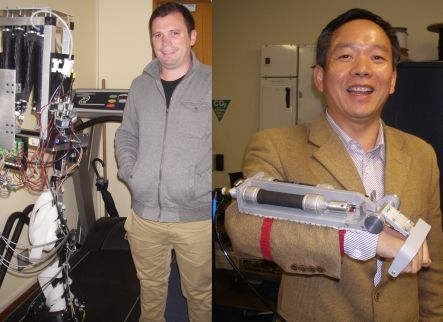
Andrew McDaid (left) with the prototype leg exoskeleton powered by air muscles, and Shane Xie (right) demonstrates a hand rehabilitation device. Photos: RNZ/A. Ballance)
Mechatronics is multi-disciplinary engineering. Originally combining mechanical and electronical engineering – hence the name – computer engineering now plays a significant role as well. An example of a mechatronics system is an industrial robot.
Shengquan (Shane) Xie heads the Medical and Rehabilitation Robotics Research Group in the Department of Mechanical Engineering at the University of Auckland.
Research fellow Andrew McDaid uses mechatronics to design wearable medical devices that can assist in gait rehabilitation for people who have had a stroke or who have incomplete spinal cord injuries. He has developed the prototype of a leg rehabilitation exoskeleton that uses air muscles to move the device, and he hopes to have it in clinical trials within a few months.
PhD student James Pau is developing a neuromuscular interface that intercepts and interprets tiny muscular movements that can be used to move a device.
The group is also working on detecting brain signals that have the intention of moving muscles, with the idea that in future these might help control an exoskeleton or even a wheelchair – at the moment the group report they can send a message on a mobile phone without actually touching the phone but by detecting electrical signals from the brain.

